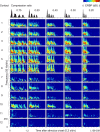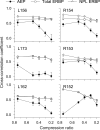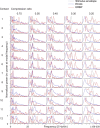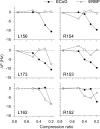Temporal envelope of time-compressed speech represented in the human auditory cortex
- PMID: 20007480
- PMCID: PMC2851231
- DOI: 10.1523/JNEUROSCI.3065-09.2009
Temporal envelope of time-compressed speech represented in the human auditory cortex
Abstract
Speech comprehension relies on temporal cues contained in the speech envelope, and the auditory cortex has been implicated as playing a critical role in encoding this temporal information. We investigated auditory cortical responses to speech stimuli in subjects undergoing invasive electrophysiological monitoring for pharmacologically refractory epilepsy. Recordings were made from multicontact electrodes implanted in Heschl's gyrus (HG). Speech sentences, time compressed from 0.75 to 0.20 of natural speaking rate, elicited average evoked potentials (AEPs) and increases in event-related band power (ERBP) of cortical high-frequency (70-250 Hz) activity. Cortex of posteromedial HG, the presumed core of human auditory cortex, represented the envelope of speech stimuli in the AEP and ERBP. Envelope following in ERBP, but not in AEP, was evident in both language-dominant and -nondominant hemispheres for relatively high degrees of compression where speech was not comprehensible. Compared to posteromedial HG, responses from anterolateral HG-an auditory belt field-exhibited longer latencies, lower amplitudes, and little or no time locking to the speech envelope. The ability of the core auditory cortex to follow the temporal speech envelope over a wide range of speaking rates leads us to conclude that such capacity in itself is not a limiting factor for speech comprehension.
Figures











Similar articles
-
Representation of speech in human auditory cortex: is it special?Hear Res. 2013 Nov;305:57-73. doi: 10.1016/j.heares.2013.05.013. Epub 2013 Jun 18. Hear Res. 2013. PMID: 23792076 Free PMC article.
-
Coding of repetitive transients by auditory cortex on Heschl's gyrus.J Neurophysiol. 2009 Oct;102(4):2358-74. doi: 10.1152/jn.91346.2008. Epub 2009 Aug 12. J Neurophysiol. 2009. PMID: 19675285 Free PMC article.
-
Functional organization of human auditory cortex: investigation of response latencies through direct recordings.Neuroimage. 2014 Nov 1;101:598-609. doi: 10.1016/j.neuroimage.2014.07.004. Epub 2014 Jul 12. Neuroimage. 2014. PMID: 25019680 Free PMC article.
-
Stimulus-dependent activations and attention-related modulations in the auditory cortex: a meta-analysis of fMRI studies.Hear Res. 2014 Jan;307:29-41. doi: 10.1016/j.heares.2013.08.001. Epub 2013 Aug 11. Hear Res. 2014. PMID: 23938208 Review.
-
How do auditory cortex neurons represent communication sounds?Hear Res. 2013 Nov;305:102-12. doi: 10.1016/j.heares.2013.03.011. Epub 2013 Apr 17. Hear Res. 2013. PMID: 23603138 Review.
Cited by
-
Sound representation in higher language areas during language generation.Proc Natl Acad Sci U S A. 2015 Feb 10;112(6):1868-73. doi: 10.1073/pnas.1418162112. Epub 2015 Jan 26. Proc Natl Acad Sci U S A. 2015. PMID: 25624479 Free PMC article.
-
Processing of facial emotion in the human fusiform gyrus.J Cogn Neurosci. 2012 Jun;24(6):1358-70. doi: 10.1162/jocn_a_00175. Epub 2011 Dec 20. J Cogn Neurosci. 2012. PMID: 22185494 Free PMC article. Clinical Trial.
-
Efficient Neural Coding in Auditory and Speech Perception.Trends Neurosci. 2019 Jan;42(1):56-65. doi: 10.1016/j.tins.2018.09.004. Epub 2018 Oct 5. Trends Neurosci. 2019. PMID: 30297085 Free PMC article. Review.
-
Decoding speech from spike-based neural population recordings in secondary auditory cortex of non-human primates.Commun Biol. 2019 Dec 11;2:466. doi: 10.1038/s42003-019-0707-9. eCollection 2019. Commun Biol. 2019. PMID: 31840111 Free PMC article.
-
Best sensitivity of temporal modulation transfer functions in laboratory mice matches the amplitude modulation embedded in vocalizations.J Acoust Soc Am. 2020 Jan;147(1):337. doi: 10.1121/10.0000583. J Acoust Soc Am. 2020. PMID: 32006990 Free PMC article.
References
-
- Ahissar E, Ahissar M. Processing of the temporal envelope of speech. In: König R, Heil P, Budinger E, Scheich H, editors. The auditory cortex: a synthesis of human and animal research. Mahwah, NJ: Erlbaum; 2005. pp. 295–314.
-
- Barth DS, Di S. Three-dimensional analysis of auditory-evoked potentials in rat neocortex. J Neurophysiol. 1990;64:1527–1536. - PubMed
-
- Bendor D, Wang X. Differential neural coding of acoustic flutter within primate auditory cortex. Nat Neurosci. 2007;10:763–771. - PubMed
Publication types
MeSH terms
Grants and funding
LinkOut - more resources
Full Text Sources
Other Literature Sources
